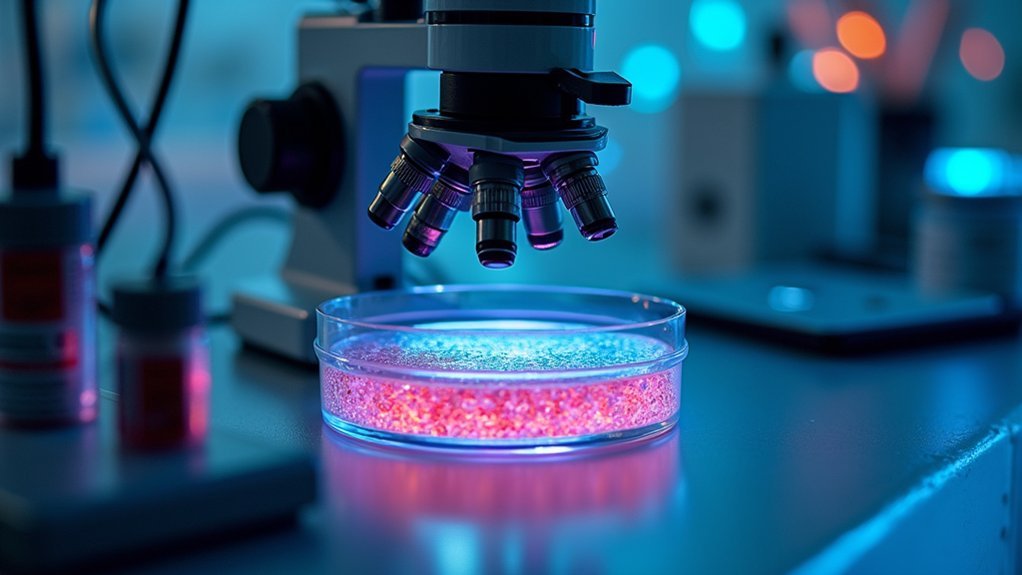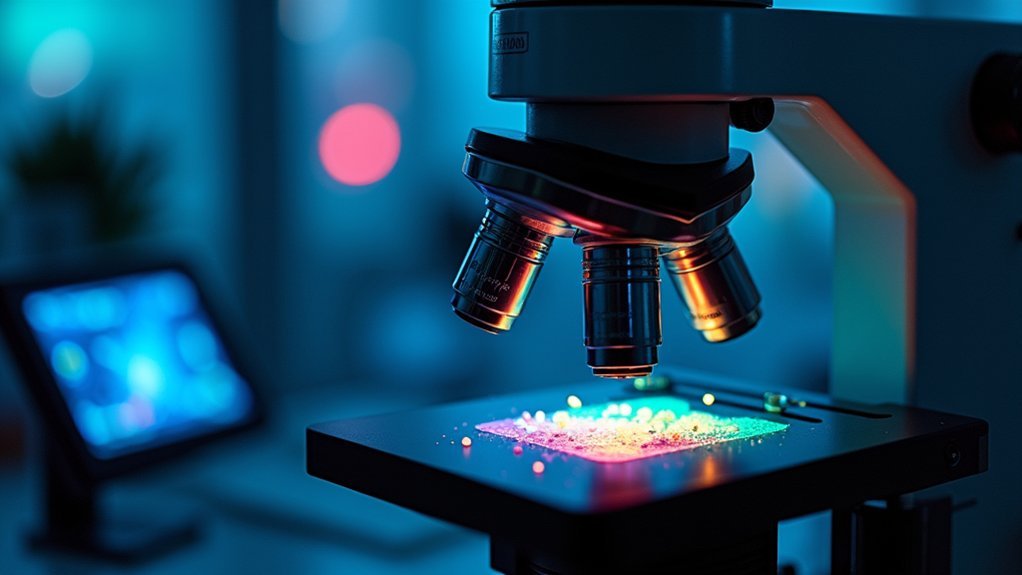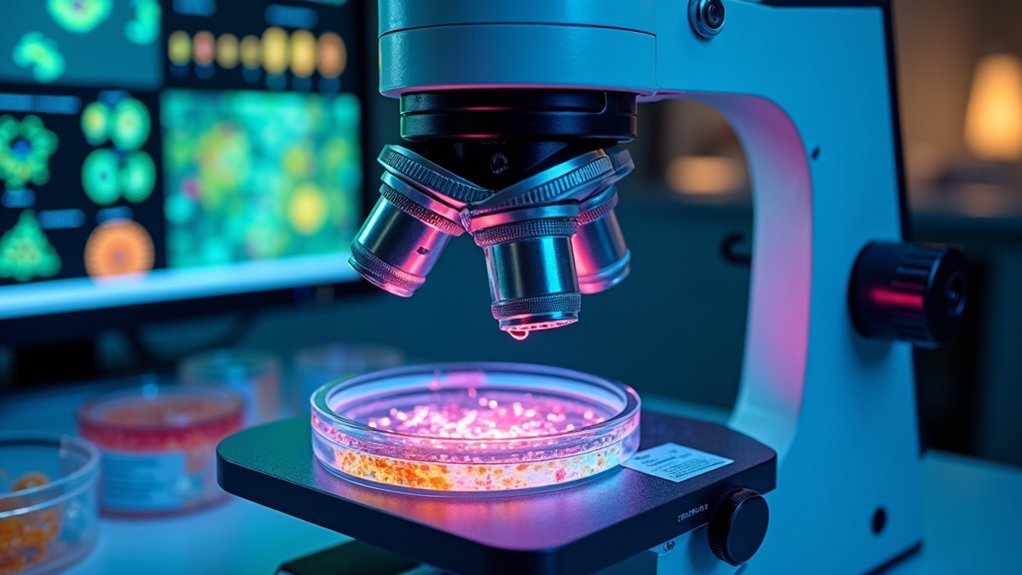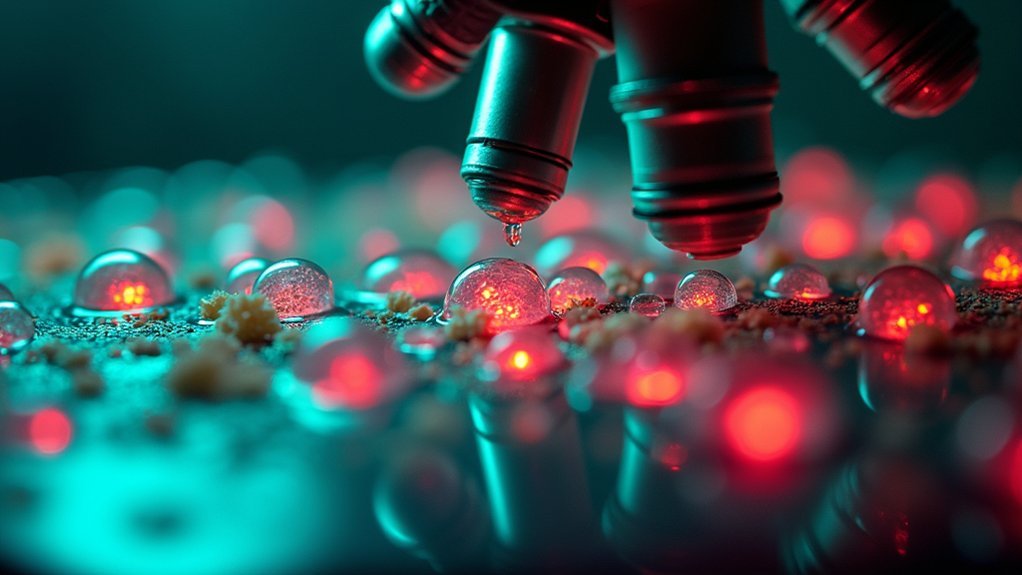For perfect live bio-imaging results, you’ll need to control environmental conditions (37°C, 5% CO2, 95% humidity), implement reliable autofocus techniques, and minimize phototoxicity by selecting red-spectrum fluorophores and reducing exposure times. Use phenol red-free media to decrease autofluorescence and apply deconvolution to enhance image quality. Don’t forget to monitor oxygen levels for your specific cell type and clean equipment regularly. These five key strategies will transform your cellular visualization capabilities.
Optimizing Environmental Conditions for Cell Viability

While capturing stunning live-cell images depends on your microscope’s quality, the microenvironment surrounding your cells ultimately determines experimental success.
Maintaining temperature at 37°C with 5% CO2 and 95% humidity creates the ideal foundation for cell health during imaging sessions.
Environmental precision is non-negotiable—37°C, 5% CO2, and 95% humidity ensure cellular stability throughout crucial imaging workflows.
Don’t overlook buffer selection—HEPES effectively stabilizes pH when CO2 levels fluctuate in closed systems.
To prevent osmolarity changes that stress cells, use larger volumes of imaging media to minimize evaporation and maintain nutrient consistency.
Choose phenol red-free media to reduce autofluorescence interference without compromising cellular integrity.
Remember that different cell types have specific oxygen level requirements—regular monitoring guarantees cells behave naturally throughout your observation period.
With proper environmental control, you’ll achieve more reliable and physiologically relevant results in your live bio-imaging experiments.
Mastering Autofocus Techniques for Long-Term Experiments
The success of long-term live-cell imaging hinges on maintaining perfect focus as cells move and change over hours or days. Implement hardware autofocus for rapid adjustments that minimize photobleaching while tracking cell division and movement.
You’ll achieve greater focus precision by utilizing software autofocus features that adapt to varying sample conditions automatically.
Configure your imaging system with MetaXpress® software to create autofocus routines tailored to your specific assay requirements. To protect your samples, use transmitted light for initial focusing—this reduces exposure time and prevents damage to live cells before imaging begins.
Don’t overlook the importance of well insert routines that detect focus peaks, optimizing Z-positioning to capture cellular dynamics accurately. These techniques guarantee consistent image quality throughout extended experiments, even as cells undergo significant morphological changes.
Minimizing Phototoxicity Through Strategic Light Management

Phototoxicity represents one of the greatest challenges in live cell imaging, potentially compromising your experiment’s integrity through cell damage or death.
To minimize phototoxicity, select high signal-to-noise, photostable fluorophores that require less excitation light intensity. Opt for red-spectrum fluorophores, which cause less photodamage than blue or UV-emitting alternatives.
Reduce exposure times and lower light intensity settings whenever possible to preserve cell viability. Implement hardware and software autofocus systems to maintain focus without subjecting your live cells to unnecessary illumination.
Throughout your experiment, continuously monitor cellular responses and adjust imaging parameters accordingly. This dynamic approach helps you capture quality images while protecting your samples from photodamage, ensuring your results reflect true biological processes rather than artifacts of light-induced stress.
Advanced Image Processing and Deconvolution Methods
Advanced image processing methods have evolved considerably to address the unique challenges of live-cell imaging, with deconvolution standing out as a particularly powerful technique.
When you apply deconvolution to your widefield microscopy images, you’ll dramatically enhance resolution by reducing out-of-focus light—all without increasing exposure times that could damage your specimens.
- Boost your signal-to-noise ratio to detect fainter fluorescence signals critical for understanding dynamic cellular processes
- Prevent artifacts that could misrepresent biological phenomena by carefully optimizing your deconvolution parameters
- Streamline your image processing workflow using deconvolution software integrated with high-content analysis systems
Troubleshooting Common Live-Cell Imaging Challenges

While image processing enhances your data quality post-acquisition, successfully capturing viable live-cell images requires overcoming several technical hurdles first. During your live cell imaging experiment, phototoxicity poses a significant risk—reduce excitation light intensity and limit image capture frequency to prevent cell damage.
| Challenge | Solution |
|---|---|
| Phototoxicity | Lower light intensity, reduce exposure times |
| Cell drift | Use low magnification lenses, implement autofocus or Z-stack functions |
| Environmental instability | Maintain constant temperature and humidity |
Clean your imaging equipment regularly to prevent contamination that compromises data accuracy. When tracking dynamic cellular processes, opt for wide-field fluorescence imaging with shorter exposure times to avoid missing essential movements. These adjustments will help maintain cell viability while ensuring you capture meaningful biological events throughout your imaging session.
Frequently Asked Questions
How Do Transgenic Fluorescent Markers Affect Natural Cell Behavior?
Your transgenic fluorescent markers can potentially alter natural cell behavior through protein interaction disruptions, phototoxicity when illuminated, and metabolic burden from expressing exogenous proteins. Always validate results with non-fluorescent controls.
Can Machine Learning Automate Live-Cell Image Analysis Workflows?
Yes, you’ll find machine learning tremendously automates live-cell analysis workflows. It can segment cells, track movements, quantify morphological changes, and identify patterns in your imaging data with minimal manual intervention.
How Often Should Culture Media Be Replaced During Multi-Day Imaging?
You’ll need to replace culture media every 24-48 hours during multi-day imaging. For sensitive cells, change it daily, while hardier cells can tolerate 48-hour intervals. Monitor pH indicators closely for ideal timing.
Are Silicone-Based Chambers Better Than Glass for Specific Applications?
Silicone chambers are better for gas exchange and flexible mounting, while glass excels for high-resolution imaging. You’ll want silicone for long-term cultures or 3D models, but glass when optical clarity is paramount.
What Mounting Strategies Minimize Cellular Stress During Vertical Positioning?
You’ll reduce cellular stress during vertical positioning by using medium-filled chambers with slow rotation, gentle adhesives for anchoring, and temperature control. Don’t overtighten mounts, and add anti-drift agents to prevent settling.
In Summary
You’ve now explored the critical elements of successful live bio-imaging. By controlling environmental conditions, mastering autofocus, managing light exposure, employing advanced processing techniques, and knowing how to troubleshoot common issues, you’ll capture clearer, more reliable data. Remember, perfecting these practices isn’t just about better images—it’s about ensuring your living specimens tell their true biological story through your microscope’s lens.





Leave a Reply